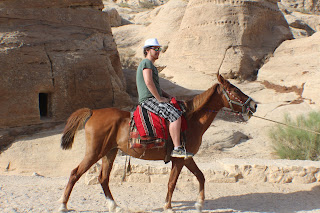We left Amman early in the morning and headed for a Greek Orthodox church in Madaba. The
Map of Madaba mosaic was discovered in 1896 and the findings were published a year later. This discovery drew the attention of scholars worldwide. It also positively influenced the inhabitants, who shared the contagious passion of
F. Giuseppe Manfredi, to whom the rediscovery of most of the city's mosaics are owed. Madaba became known as the "City of Mosaics" in Jordan.
The Madaba Mosaic Map is an index map of the region, dating from the 6th century, preserved in the floor of the
Greek Orthodox Basilica of
Saint George. With two million pieces of colored stone, the map depicts hills and valleys, villages and towns in Palestine and the Nile Delta. The mosaic contains the earliest extant representation of Byzantine
Jerusalem, labeled the "Holy City." The map provides important details as to its 6th-century landmarks, with the
cardo, or central colonnaded street and the
Holy Sepulchre clearly visible. This map is one key in developing scholarly knowledge about the physical layout of Jerusalem after its destruction and rebuilding in 70 AD.
From Madaba we headed for Mt Nebo. According to the final chapter of
Deuteronomy,
Moses ascended Mount Nebo to view the
Land of Israel: And Moses went up from the plains of Moab to Mount Nebo, the top of
Pisgah, which is opposite
Jericho [1].
According to
Christian tradition, Moses was buried on the mountain, although his place of burial is not specified. Some Islamic traditions also stated the same,
[2] although there is a grave of Moses located at Maqam El-Nabi Musa which lies 11 km (6.8 mi) south of
Jericho and 20 km (12 mi) east of
Jerusalem in the
Judean wilderness.
[3] Scholars continue to dispute whether the mountain currently known as Nebo is the same as the mountain referred to in the
Torah.
After Mt Nebo we headed for Al Karak where there is a big Crusader Castle. Karak, once a
Kingdom,
[3] lies 140 km to the south of
Amman on the
King's Highway. An ancient Crusader stronghold, it is situated on a hilltop about 1000 meters above sea level and is surrounded on three sides by a valley. Karak has a view of the
Dead Sea. A city of about 20,000 people has been built up around the castle, and it has buildings from 19th century
Ottoman period. The town is built on a triangular plateau, with the castle at its narrow southern tip, but it is undoubtedly Karak Castle which dominates.
From Al Karak we were off to Petra in Wadi Musa. (Valley of Moses)
Petra (
Arabic: البتراء, Al-Batrāʾ) is a
historical and
archaeological city in the southern
Jordanian governorate of
Ma'an, that is famous for its
rock-cut architecture and water conduit system. Another name for Petra is the Rose City due to the color of the stone out of which it is carved.
Established possibly as early as 312 BCE as the capital city of the
Nabataeans,
[1] it is a symbol of Jordan, as well as its most-visited tourist attraction.
[2] It lies on the slope of
Jebel al-Madhbah (identified by some as the biblical
Mount Hor[3]) in a
basin among the mountains which form the eastern flank of
Arabah (Wadi Araba), the large valley running from the
Dead Sea to the
Gulf of Aqaba.
The site remained unknown to the
Western world until 1812, when it was introduced by
Swiss explorer
Johann Ludwig Burckhardt.
Tonight after tea went for a candle light presentation of Petra. The program was simple with a Bedouin playing a local Taweeda then another local played flute. We also had a drink of Beduin Tea. The tea is very sweat.
Walked back on a beautiful starry night to our Moevenpick hotel, just near the entrance to Petra city. Looking forward to seeing Petra by day.
 |
| Mosaic on the floor of the Greek Orthodox church in Madaba. |
 |
| Front of the church |
 |
| Statue to Moses on Mt Nebo |
 |
| Looking towards the Dead Sea from Mt Nebo |
 |
| Guide to distances from Mt Nebo |
 |
| The township of Al Karak |
 |
| The imposing Crusader castle |
 |
| The streets are narrow and difficult to get a full size coach through |
 |
| Obstacles like cars are just lifted out of the way. |
 |
| Crusader castle |
 |
| The Kitchen inside the Castle |
 |
| A room with a view |
 |
The windows weren't that good, but useful
for shooting arrows or throwing rocks on
uninvited guests. |
 |
| A flock of sheep |
 |
| The Hotel Lobby |
 |
| Entrance to Petra at night |
 |
| Water Fountains |
 |
| Pretend Jordanians |
 |
| Candles by night in Petra |
 |
| Beduin Playing the Taweeda amongst the candles |
 |
| Candles infront of the Treasury Entrance |
 |
| The town outside our Hotel at night. |


















































